A Network Modelling Approach to Flight Delay Propagation: Some Empirical Evidence from China
Abstract
1. Introduction
2. Delay Propagation Model
2.1. Delay Propagation Process
2.2. Flight-Based Susceptible-Infected-Susceptible Model
| Algorithm 1 FSIS model simulation process |
| 1: Input: 2: Output: 3: for do 4: for do 5: Generate from the translog model; 6: Calculate using Equation (3); 7: end for 8: end for |
3. The Translog Model of Delay Propagation
3.1. Delay Propagation Probability
3.2. Elastic Analysis of Delay Propagation
3.3. Flight Delay Analysis of Airlines
4. Flight Delay Propagation Based on the FSIS Model
4.1. Airport Operation
4.2. Network Effects
4.3. Controlling Delay
5. Conclusions
Supplementary Materials
Author Contributions
Funding
Conflicts of Interest
References
- Xiong, C.; Beckmann, V.; Tan, R. Effects of Infrastructure on Land Use and Land Cover Change (LUCC): The Case of Hangzhou International Airport, China. Sustainability 2018, 10, 2013. [Google Scholar] [CrossRef]
- IATA Annual Report. Available online: https://www.iata.org/publications/economics/pages/index.aspx (accessed on 15 January 2017).
- Wu, W.; Zhang, H.; Wei, W. Optimal Design of Hub-and-Spoke Networks with Access to Regional Hub Airports: A Case for the Chinese Regional Airport System. Transportmetrica A. 2018, 1–28. [Google Scholar] [CrossRef]
- Chen, Y.; Yu, J.; Tsai, S.B.; Zhu, J. An Empirical Study on the Indirect Impact of Flight Delay on China’s Economy. Sustainability 2018, 10, 357. [Google Scholar] [CrossRef]
- Schultz, M.; Schmidt, M. Advancements in Passenger Processes at Airports from Aircraft Perspective. Sustainability 2018, 10, 3877. [Google Scholar] [CrossRef]
- Kafle, N.; Zou, B. Modeling flight delay propagation: A new analytical-econometric approach. Transp. Res. Part B Methodol. 2016, 93, 520–542. [Google Scholar] [CrossRef]
- Sternberg, A.; Carvalho, D.; Murta, L.; Soares, J.; Ogasawara, E. An analysis of Brazilian flight delays based on frequent patterns. Transp. Res. Part E Logist. Transp. Rev. 2016, 95, 282–298. [Google Scholar] [CrossRef]
- Zou, B.; Hansen, M. Flight delays, capacity investment and social welfare under air transport supply-demand equilibrium. Transp. Res. Part A Policy Pract. 2012, 46, 965–980. [Google Scholar] [CrossRef]
- Wu, W.; Wu, C.L.; Feng, T.; Zhang, H.; Qiu, S. Comparative Analysis on Propagation Effects of Flight Delays: A Case Study of China Airline. J. Adv. Transport. 2018, 1915, 1–10. [Google Scholar] [CrossRef]
- Yan, S.; Wang, C. The planning of aircraft routes and flight frequencies in an airline network operations. J. Adv. Transport. 2010, 35, 33–46. [Google Scholar] [CrossRef]
- Bolić, T.; Castelli, L.; Corolli, L.; Rigonat, D. Reducing ATFM delays through strategic flight planning. Transp. Res. Part E Logist. Transp. Rev. 2017, 98, 42–59. [Google Scholar] [CrossRef]
- Kondo, A. Delay Propagation and Multiplier. In Proceedings of the Forum in its Series 51st Annual Transportation Research Forum, Arlington, Virginia, 11–13 March 2010. [Google Scholar]
- Simaiakis, I.; Pyrgiotis, N. An Analytical Queuing Model of Airport Departure Processes for Taxi Out Time Prediction. In Proceedings of the 10th AIAA Aviation Technology, Integration, and Operations (ATIO) Conference, Fort Worth, TX, USA, 13–15 September 2010. [Google Scholar]
- AhmadBeygi, S.; Cohn, A.; Lapp, M. Decreasing airline delay propagation by re-allocating scheduled slack. IIE Trans. 2010, 42, 478–489. [Google Scholar] [CrossRef]
- Takeichi, N. Nominal flight time optimization for arrival time scheduling through estimation/resolution of delay accumulation. Transp. Res. Part C Emerg. Technol. 2017, 77, 433–443. [Google Scholar] [CrossRef]
- Montlaur, A.; Delgado, L. Flight and passenger delay assignment optimization strategies. Transp. Res. Part C Emerg. Technol. 2017, 81, 99–117. [Google Scholar] [CrossRef]
- Pyrgiotis, N.; Malone, K.M.; Odoni, A. Modelling delay propagation within an airport network. Transp. Res. Part C Emerg. Technol. 2013, 27, 60–75. [Google Scholar] [CrossRef]
- Baspinar, B.; Ure, N.K.; Koyuncu, E.; Inalhan, G. Analysis of Delay Characteristics of European Air Traffic through a Data-Driven Airport-Centric Queuing Network Model. IFAC Papers Online 2016, 49, 359–364. [Google Scholar] [CrossRef]
- Jetzki, M. The Propagation of Air Transport Delays in Europe. Ph.D. Thesis, RWTH Aachen University, Aachen, Germany, 2009. [Google Scholar]
- Marín, A.G. Airport Taxi Planning: Lagrangian Decomposition. J. Adv. Transport. 2013, 47, 461–474. [Google Scholar] [CrossRef]
- Dietz, K.; Heesterbeek, J. Daniel Bernoulli’s epidemiological model revisited. Math. Biosci. 2002, 180, 1–21. [Google Scholar] [CrossRef]
- Nicolas, B. A Short History of Mathematical Population Dynamics; Springer: London, UK, 2011; Volume 4, pp. 820–821. [Google Scholar]
- Asfe, M.K.; Zehi, M.J.; Tash, M.N.S.; Yaghoubi, N.M. Ranking different factors influencing flight delay. Manag. Sci. Lett. 2014, 4, 1397–1400. [Google Scholar] [CrossRef]
- Zámková, M.; Prokop, M. The Evaluation of Factors Influencing Flights Delay at Czech International Airports. Acta Univ. Agric. Silvic. Mendel. Brun. 2015, 63, 2187–2196. [Google Scholar] [CrossRef]
- Baspinar, B.; Koyuncu, E. A Data-Driven Air Transportation Delay Propagation Model Using Epidemic Process Models. Int. J. Aerosp. Eng. 2016, 2016, 1–11. [Google Scholar] [CrossRef]
- Nowzari, C.; Preciado, V.M.; Pappas, G. Analysis and Control of Epidemics: A Survey of Spreading Processes on Complex Networks. IEEE Control Syst. 2016, 36, 26–46. [Google Scholar]
- Yang, X.H.; Wang, B.; Chen, S.Y.; Wang, W.L. Epidemic dynamics behavior in some bus transport networks. Phys. A Stat. Mech. Appl. 2012, 391, 917–924. [Google Scholar] [CrossRef]
- Lan, S.; Clarke, J.P.; Barnhart, C. Planning for Robust Airline Operations: Optimizing Aircraft Routings and Flight Departure Times to Minimize Passenger Disruptions. Transp. Sci. 2006, 40, 15–28. [Google Scholar] [CrossRef]
- Altunbas, Y.; Chakravarty, S. Frontier cost functions and bank efficiency. Econ. Lett. 2001, 72, 233–240. [Google Scholar] [CrossRef]

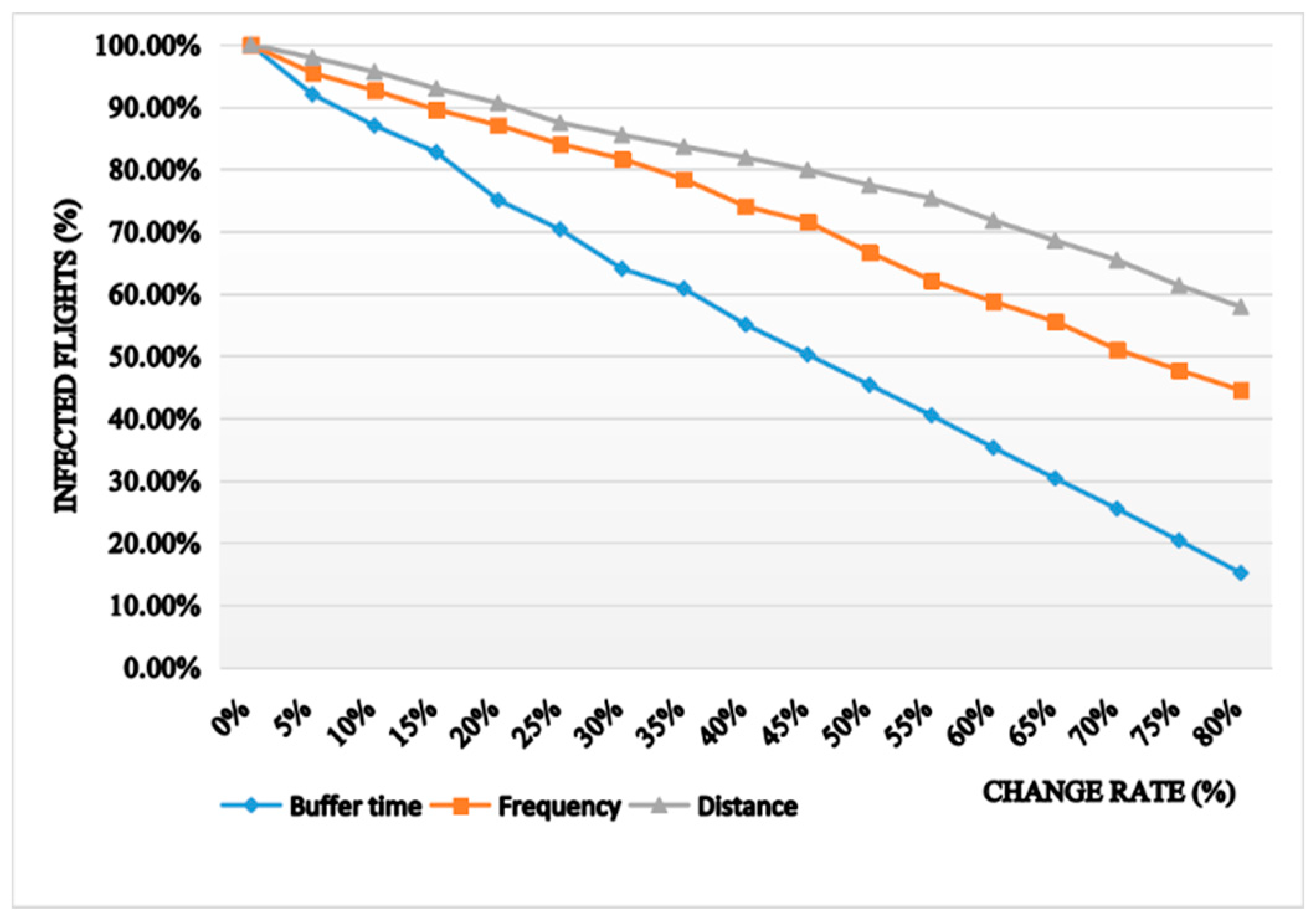
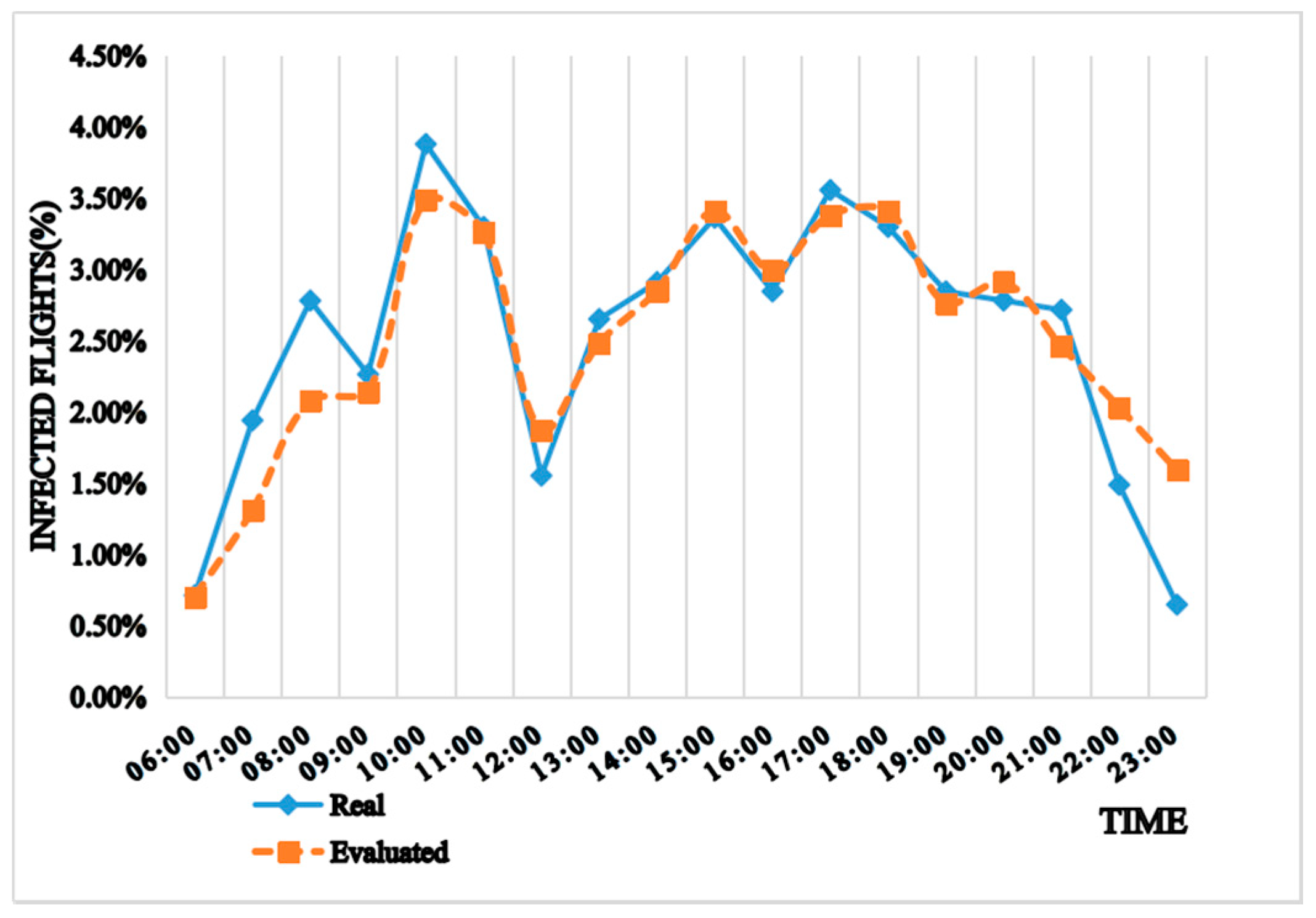

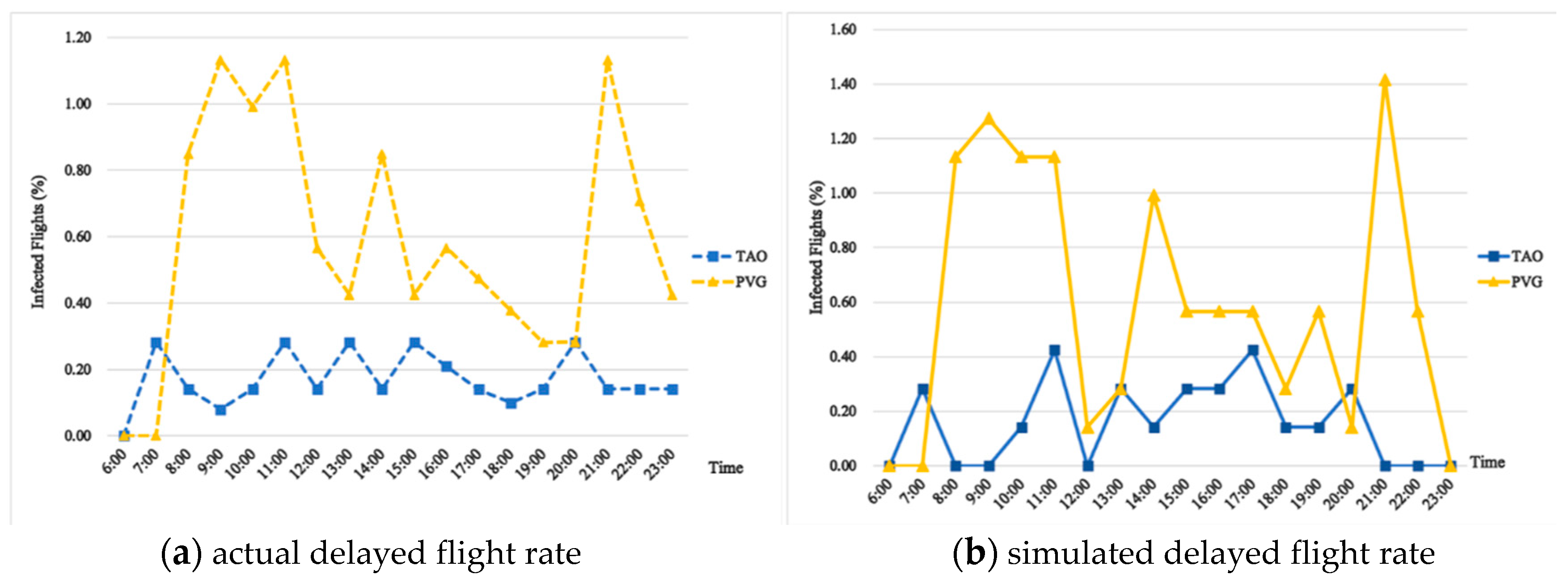

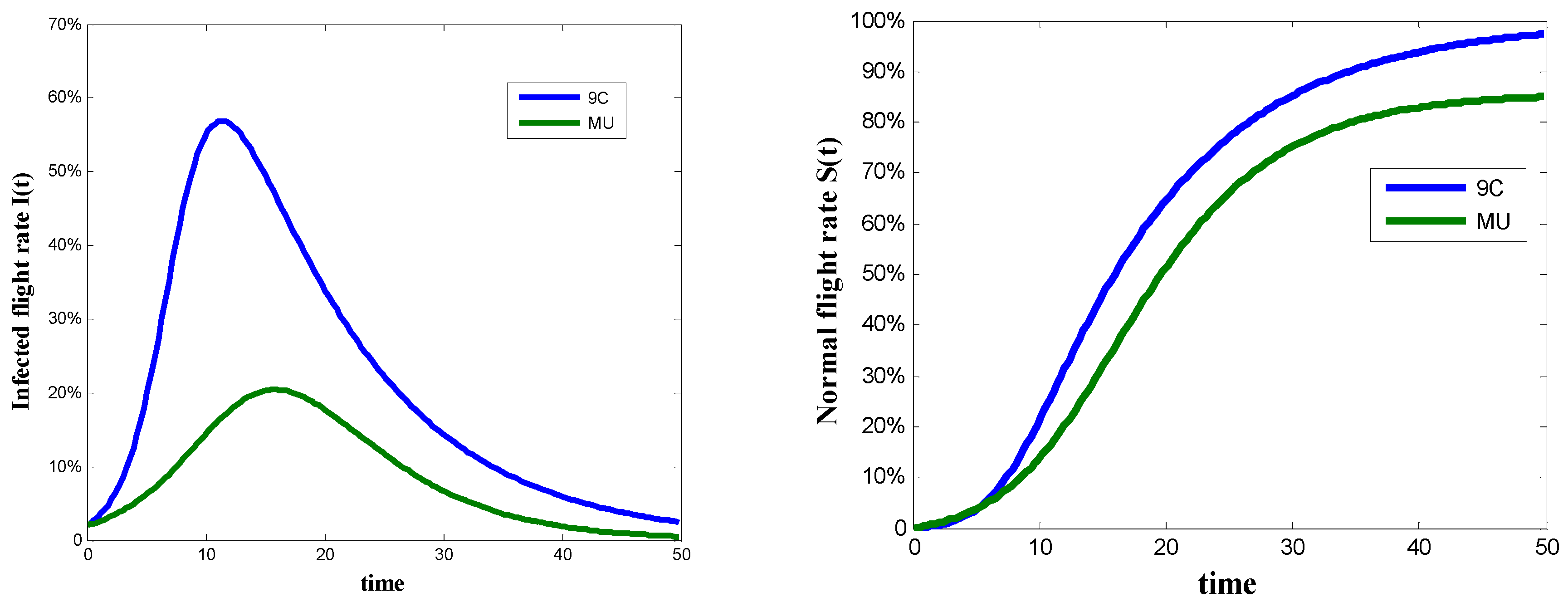
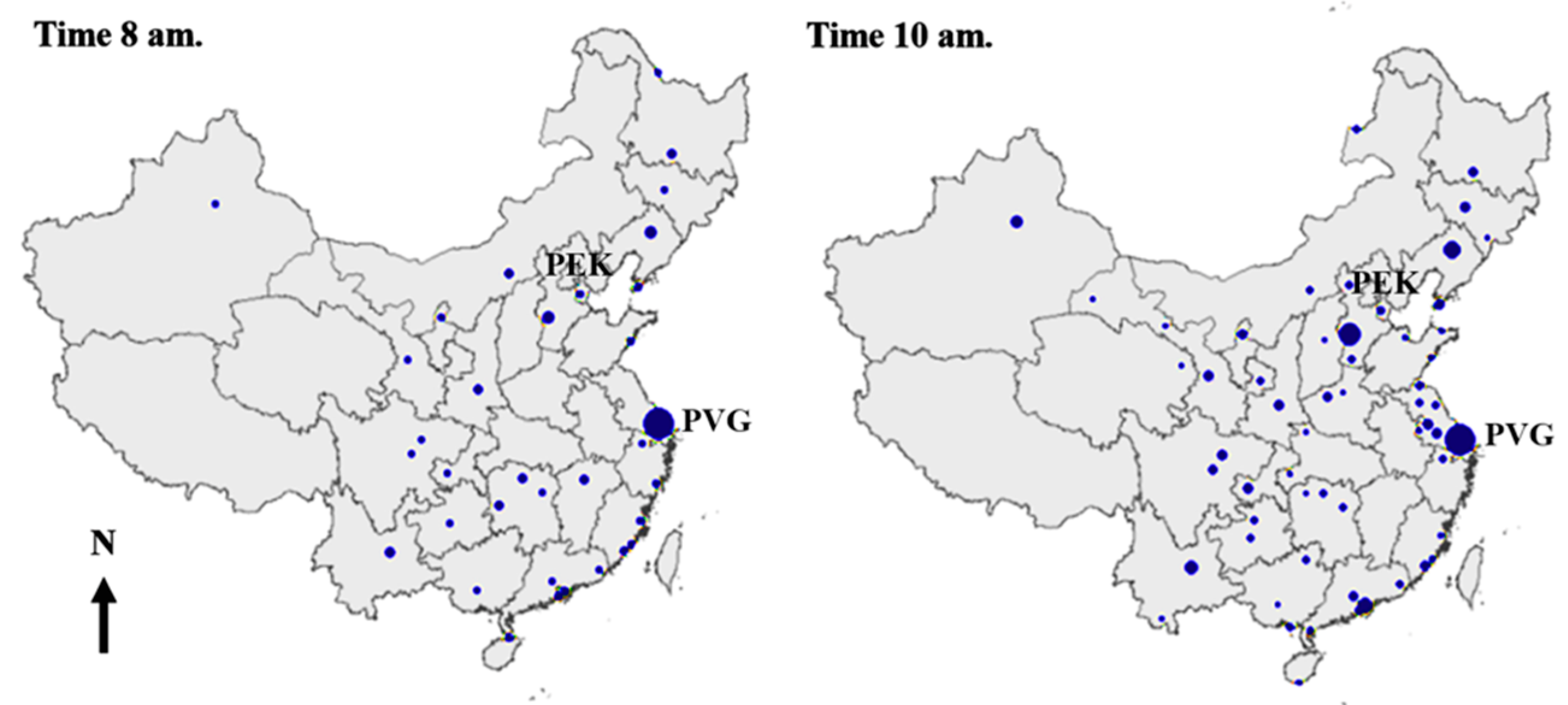
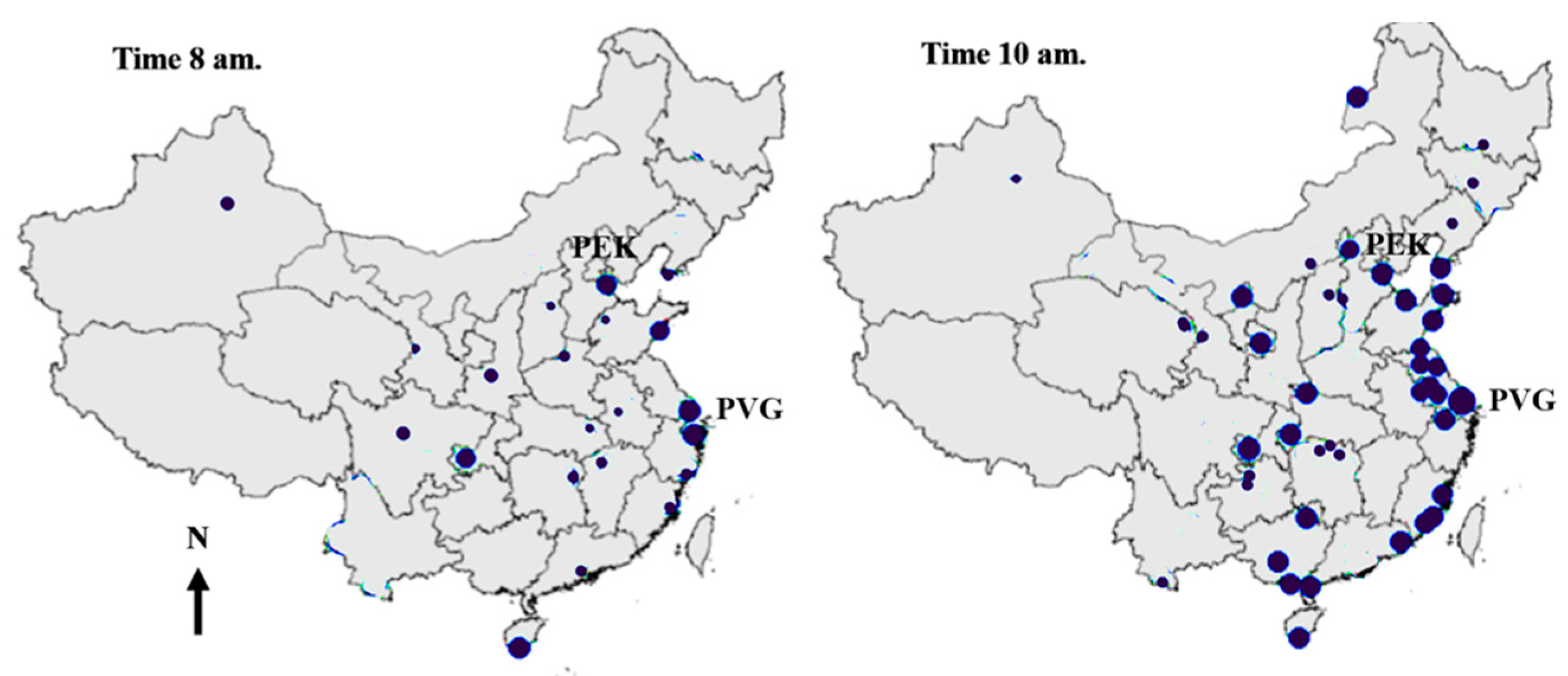
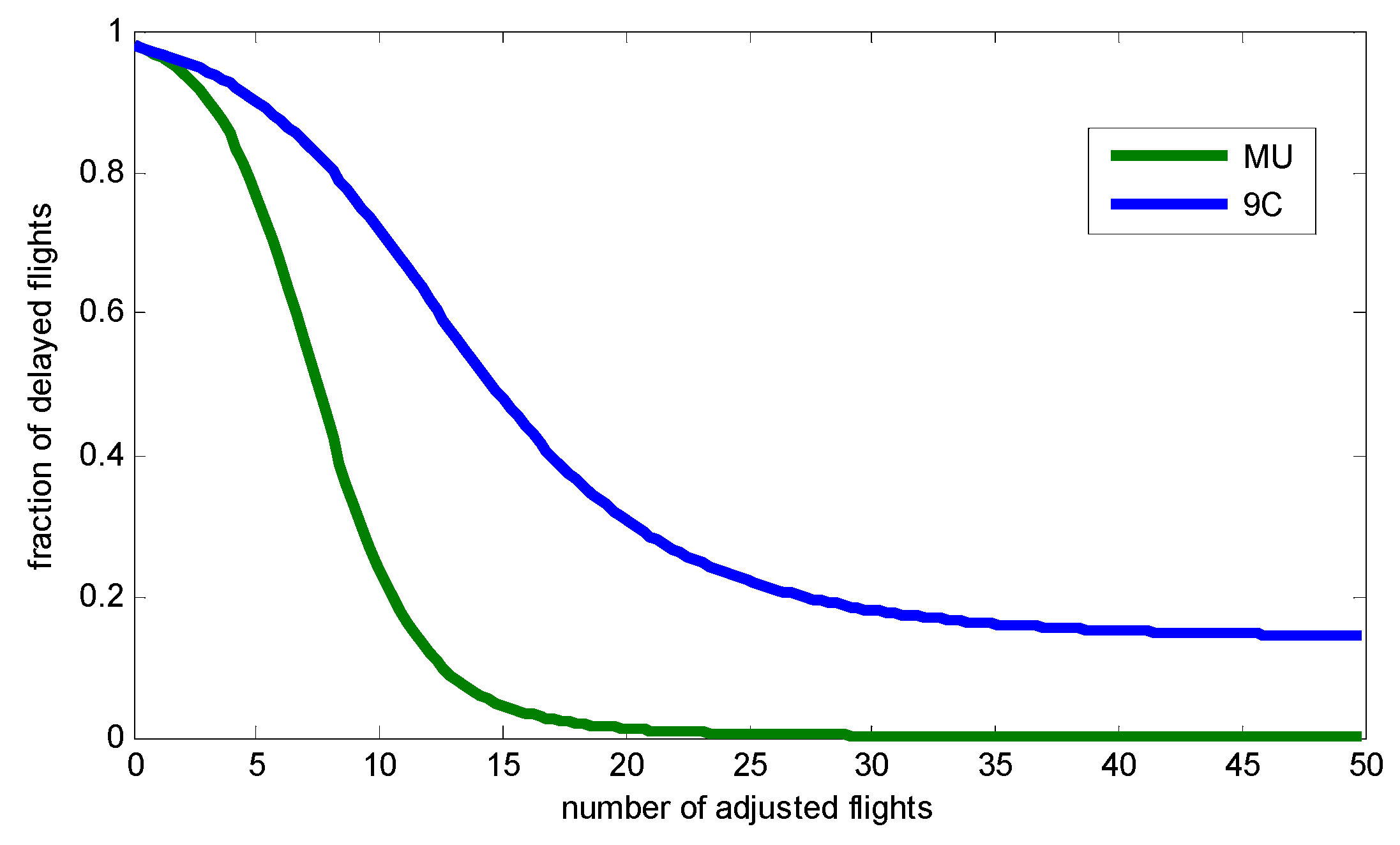
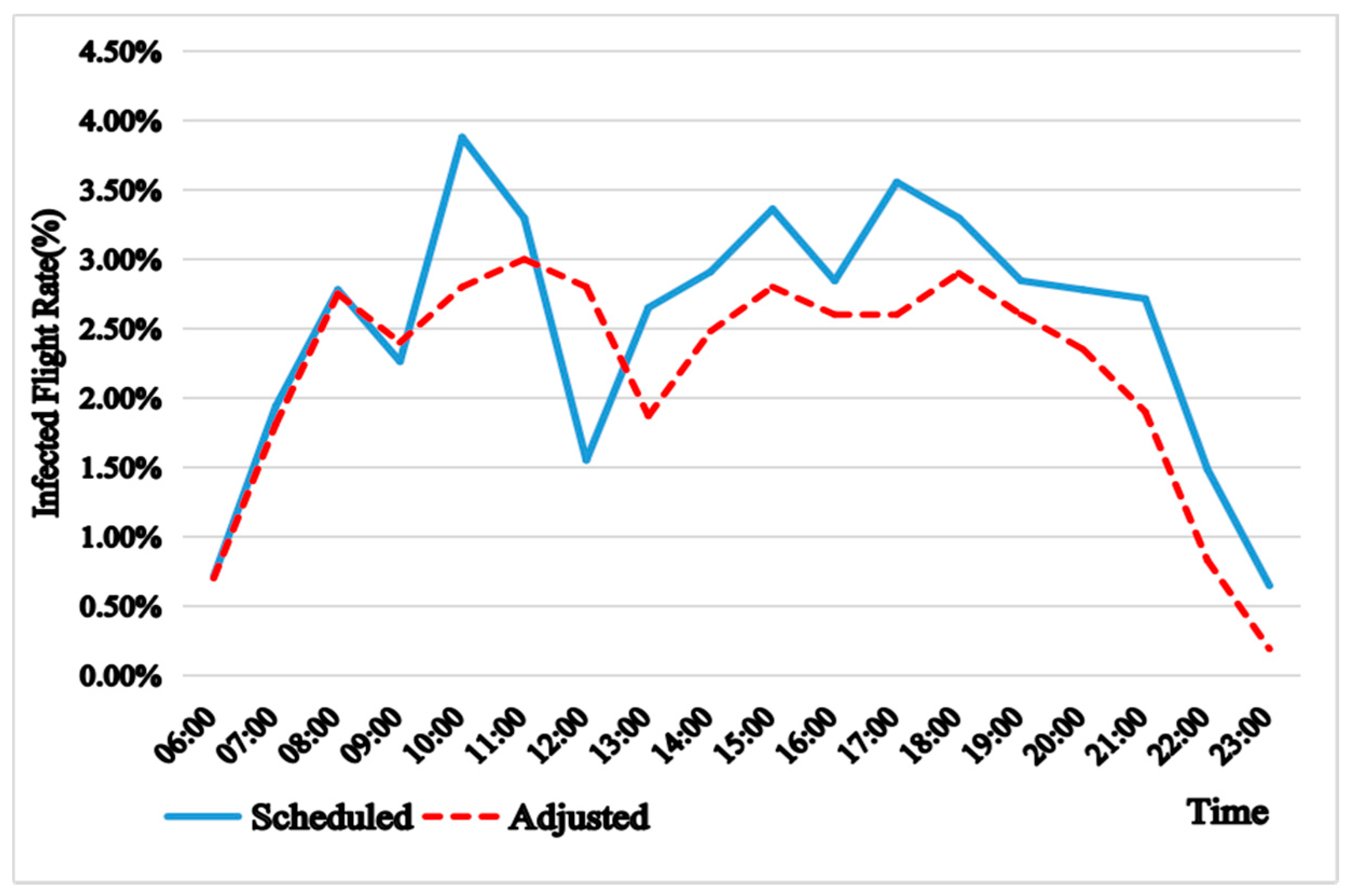
| Explanatory Variable | Infection Rate Function | |
| Estimated Coefficients | t-Statistic | |
| Movement | 1.89 | 31.53 |
| Distance | −0.32 | −10.25 |
| Buffer time | −1.76 | −44.37 |
| Propagated delay | 1.81 | 20.03 |
| Movement * Movement | 0.45 | 9.22 |
| Movement * Distance | 1.47 | 9.57 |
| Movement * Buffer time | −1.06 | −11.63 |
| Movement * Propagated delay | 1.64 | 6.01 |
| Distance * Distance | 0.24 | 11.09 |
| Distance * Buffer time | −5.14 | −12.44 |
| Distance * Propagated delay | −1.39 | −6.10 |
| Buffer time * Buffer time | −0.72 | −4.97 |
| Buffer time * Propagated delay | −2.86 | −8.04 |
| Propagated delay * Propagated delay | 1.95 | 1.05 |
© 2019 by the authors. Licensee MDPI, Basel, Switzerland. This article is an open access article distributed under the terms and conditions of the Creative Commons Attribution (CC BY) license (http://creativecommons.org/licenses/by/4.0/).
Share and Cite
Wu, W.; Zhang, H.; Feng, T.; Witlox, F. A Network Modelling Approach to Flight Delay Propagation: Some Empirical Evidence from China. Sustainability 2019, 11, 4408. https://doi.org/10.3390/su11164408
Wu W, Zhang H, Feng T, Witlox F. A Network Modelling Approach to Flight Delay Propagation: Some Empirical Evidence from China. Sustainability. 2019; 11(16):4408. https://doi.org/10.3390/su11164408
Chicago/Turabian StyleWu, Weiwei, Haoyu Zhang, Tao Feng, and Frank Witlox. 2019. "A Network Modelling Approach to Flight Delay Propagation: Some Empirical Evidence from China" Sustainability 11, no. 16: 4408. https://doi.org/10.3390/su11164408
APA StyleWu, W., Zhang, H., Feng, T., & Witlox, F. (2019). A Network Modelling Approach to Flight Delay Propagation: Some Empirical Evidence from China. Sustainability, 11(16), 4408. https://doi.org/10.3390/su11164408






